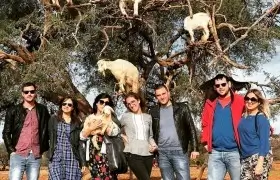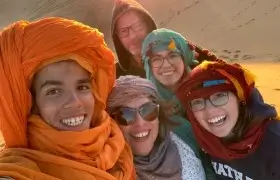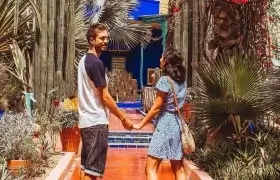Additional Services
We Also Offer
finest conditions to Morocco while ensuring your safety. Morocco is dedicated to ensuring that each and every customer has a positive experience during their whole trip.
- Wifi
- Air conditioning

Discover Morocco with our experienced travel agency. We offer customized packages and knowledgeable guides to take you on a journey through the country’s rich culture and history.
MOROCCO MULTI-DAY TOURS / DAY TRIPS & EXCURSIONS / MOROCCO DESERT TOURS / MOROCCAN CULTURE
You may begin your desert adventure in any one of Morocco numerous towns. As an example, Marrakech, Fes, Casablanca, and Tangier all have international airports. As a result, some of the itineraries shown below have been modified to better suit your needs. However, you may make your own itinerary using Morocco.
Join our Morocco vacatione and see the country like a native. The goal of our excursions is to make you feel like a local while you in Morocco. In other words, you won’t be joining any tour groups but instead will be traveling with genuine locals who will let you experience life as a Moroccan. The diversity of our nation’s cultures is one of its defining characteristics. But with our excursions, not only will you be able to learn about them, but you will also learn about their culture and beliefs.
Our tour and drivers are genuine travel pros. They come from a long line of successful entrepreneurs in Morocco. They want your morocco to be special and memorable, so they’ll do all they can to make it so. The spread of Morocan customs is our primary mission.
You may be certain that the trips and lodgings provided by Morocco will be of the highest standard. Our crew has extensive knowledge and can recommend many excellent destinations for leisure in Morocco . Individuals, groups, and families are all welcome on our trips. Additionally, we provide the opportunity to tailor your trip schedule to your specific interests and requirements.

For anyone wishing to plan a group Morocco, our service is at your disposal.

If you're taking the kids to Morocco, read this beforehand. Morocco is a travel business dedicated to providing its clients with an unforgettable experience in Morocco.

When you book with our travel agency for Morocco holidys, you may confidently explore the country on your own, regardless of your gender.

Tous of Morocco with us are perfect for honeymooners or other romantic getaways. In addition to our collegiate services, we also provide honeymoon options.
finest conditions to Morocco while ensuring your safety. Morocco is dedicated to ensuring that each and every customer has a positive experience during their whole trip.

People are always speaking so positively about our travel agency.

TRAVELER
We took a 10-day journey from Casablanca, Chefchouen, Fes, Marrakech, Merzouga, Ifrane, and Ouarzazate. Mustapha Ali was our driver and guide and made sure we were comfortable.
Mustapha made our vacation commfortable and worry-free. Mustapha was helpful and accommodating when I needed a last-minute travel and hotel arrangement. I’d certainly book again. We’ll visit Morocco again.

TRAVELER
Camel riding, stargazing, Sahara desert sunrises, ATVing in the enormous red dunes, sand surfing, strolling Fez’s artisan marketplaces, and wonderful Berber mint tea… what more could you want? I suggest this firm for Morocco.
Every email I sent to plan our vacation to Fez was replied immediately and clearly. Hamid and his colleagues were really accommodating. Eight college students wanted a cheap Morocco, and they delivered. The hotel, transportation, and dessert camp surpassed my expectations. Thanks for an unforgetable vacation!

TRAVELER
16 glorious days in the Morocan desert. We are really thankful for the generosity and assistance that Mustapha and Ali have provided. There were occasions when further information regarding the location or city was required, but we did not have any difficulties when touring any of the locations that we have visited.

TRAVLER
BEST tour business with AMAZING people!!! With pals, I recently returned from Fez and the Merzouga desert. It was amazing. We saw beautiful scenery, learned about the culture, and enjoyed sandboarding, camel rides, and ATVs. Every guide was really helpful, kind, and welcoming. We were sorry to leave our new friends after the vacation. Without this firm, our vacation to Morocco tours would not have been the same. I’ll never forget this weekend!

TRAVELER
Unquestionably the best tour ever! The staff, namely Hamid, was really nice, helpful, and patient. Hamid has a great deal of expertise and was an all-around delightful guy to be around.
There was never a moment of boredom. I spent one of the finest weekends of my life with them, and I would suggest this trip to everyone who wants to experience it! Many thanks to my recent acquaintances for making it possible for me to have such an amazing experience.
I’ve always had a passion for seeing new places, and Africa was on my bucket list. Since I was interested in learning more about visit Morocco and thought it could be nice to experience a new culture, I decided to go there. I was excited to see its reputed beauty for myself after reading several accounts of it.
Yes! It is an interesting and thrilling destination. The cuisine is deservingly famous, the sightseeing is plenty, the shopping is excellent, and the weather is Florida-like for the majority of the year. Few nations have a design style as iconic. Moroccans are often friendly and inquisitive, and discussions with them are seldom devoid of surprises.
Morocco derives a significant percentage of its money from the tourist sector, thus they ensure that visitors are treated properly. It is quite secure and tourist-friendly. There is nothing to fear, and I always encourage others to attend if they get the opportunity.
When I went, I didn’t have a plan for when I returned. I had no idea what direction to go in. I had no particular plans beyond seeing as much as I could during my time there. As soon as I got back to my house, I set about planning my next trip.
Escape Your Comfort Zone.
Explore the markets of Marrakech.
Visit the extravagant Bahia Palace.
See the Tanneries in Fez.
Visit the Merzouga Deserts.
Learn To Prepare a Tagine.
Visit the Volubilis Roman Ruins.
The Moroccan Tree Goats may be seen.
However, arguably the most crucial fact is that there is no clothing code in Morocco. You are not compelled to wear a certain manner. The inhabitants of Morocco dres in a variety of ways, and they do not expect outsiders to dress similarly.